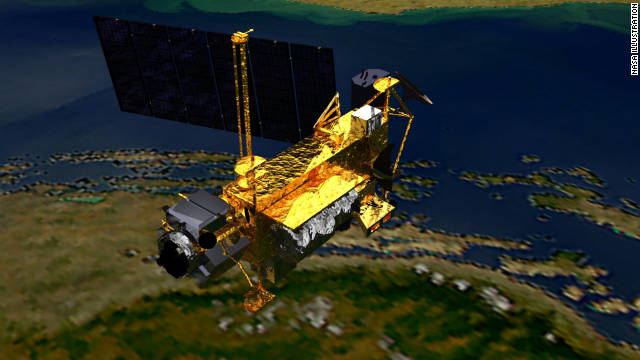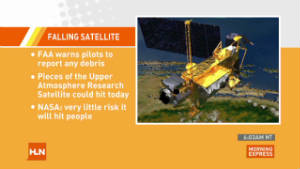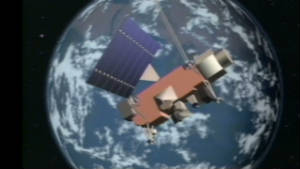U.S. is in falling satellite's potential strike zone, NASA says

NASA's Upper Atmosphere Research Satellite is expected to re-enter the atmosphere Friday or Saturday.
September 23, 2011 -- Updated 1628 GMT (0028 HKT)
The United States is once again an unlikely but potential target for the 26 pieces of the Upper Atmosphere Research Satellite, expected to survive the descent. Those pieces, made of stainless steel, titanium and beryllium that won't burn, will range from about 10 pounds to hundreds of pounds, according to NASA.
-
NASA said Friday morning that it would be hours before it would be able to zero in on the time and place of the re-entry.
Mark Matney of NASA's Orbital Debris team in Houston said there's no way to know exactly where the pieces will come down.
"Keep in mind, they won't be traveling at those high orbital velocities. As they hit the air, they tend to slow down. ... They're still traveling fast, a few tens to hundreds of miles per hour, but no longer those tremendous orbital velocities," he explained.
-
Because the satellite travels thousands of miles in a matter of minutes as it orbits -- even just before it begins re-entry -- it will be impossible to pinpoint the exact location the pieces will come down. On top of that, Matney said, the satellite is not stable.
"Part of the problem is, the spacecraft is tumbling in unpredictable ways, and it is very difficult to very precisely pinpoint where it's coming down even right before the re-entry."
 FAA: Pilots watch for falling satellite
FAA: Pilots watch for falling satellite  Where will satellite debris strike?
Where will satellite debris strike?-
Because water covers 70% of the Earth's surface, NASA has said that most if not all of the surviving debris will land in water. Even if pieces strike dry land, there's very little risk any of it will hit people.However, in an abundance of caution, the Federal Aviation Administration on Thursday released an advisory warning pilots about the falling satellite, calling it a potential hazard.
-
"It is critical that all pilots/flight crew members report any observed falling space debris to the appropriate (air traffic control) facility and include position, altitude, time and direction of debris observed," the FAA statement said.
The FAA said warnings of this sort typically are sent out to pilots concerning specific hazards they may encounter during flights such as air shows, rocket launches, kites and inoperable radio navigational aids.
NASA says space debris the size of the satellite's components re-enters the atmosphere about once year. Harvard University astrophysicist Jonathan McDowell noted that the satellite is far from being the biggest space junk to come back.
-
"This is nothing like the old Skylab scare of the '70s, when you had a 70-ton space station crashing out of the sky. So, I agree with the folks in Houston. It's nothing to be worried about," McDowell said.
Pieces of Skylab came down in western Australia in 1979.
The only wild card McDowell sees is if somehow a chunk hits a populated area.
"If the thing happens to come down in a city, that would be bad. The chances of it causing extensive damage or injuring someone are much higher."
-
NASA said that once the debris hits the atmosphere 50 miles up, it will take only a matter of minutes before the surviving pieces hit the Earth.

No comments:
Post a Comment